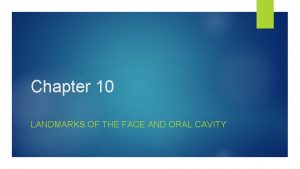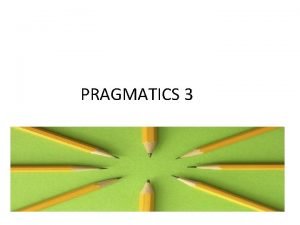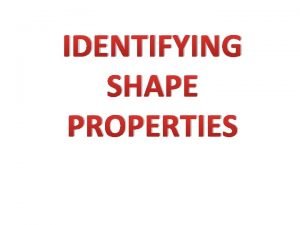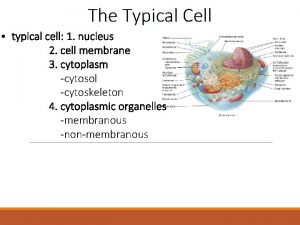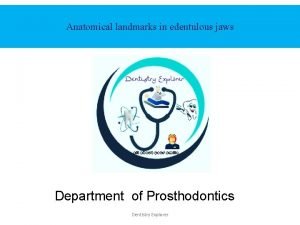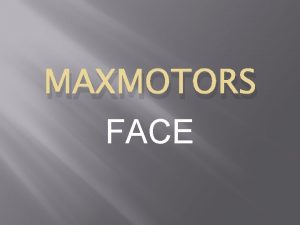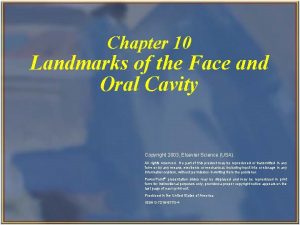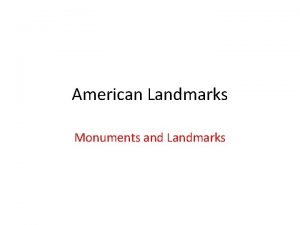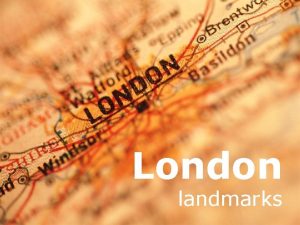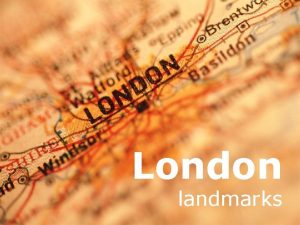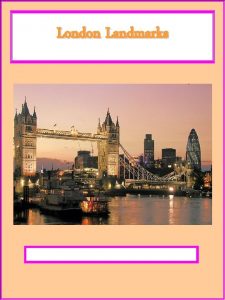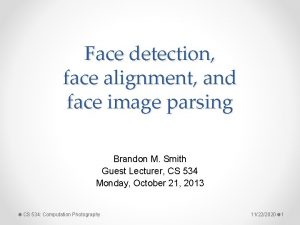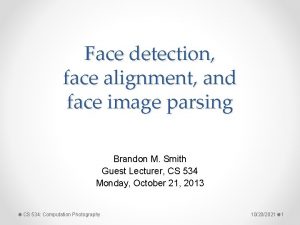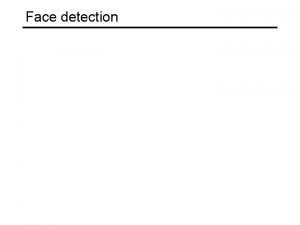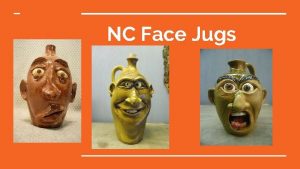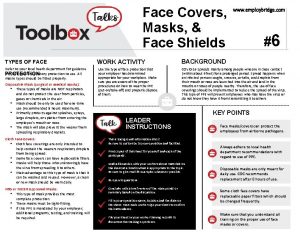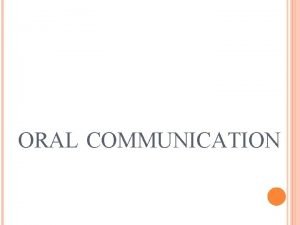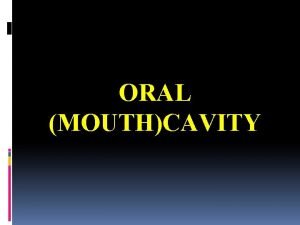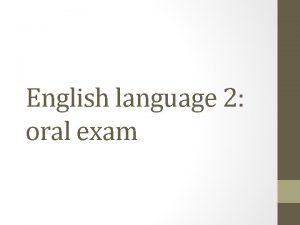Chapter 10 LANDMARKS OF THE FACE AND ORAL





























- Slides: 29

Chapter 10 LANDMARKS OF THE FACE AND ORAL CAVITY

Regions of the Face Forehead: Extending from the eyebrows to the hairline Temples: Orbital: Anterior to the eyes Eye area that is covered by the eyelids External nose

Regions of the Face cont. Zygomatic Mouth (malar): Prominence of the cheek and lips Cheeks Chin External ear

Features of the Face The dental assistant should be able to point out the following facial features: Outer and inner canthus of the eye Ala of the nose Philtrum Tragus of the ear Nasion Glabella Root or “bridge” of the nose

Features of the Face cont. The dental assistant should be able to point out the following facial features: Septum of the nasal cavity Anterior naris of the nostril Mental Angle protuberance of the mandible Zygomatic arch

Regions of the Face

Features of the Face

Skin The skin of the face is thin to medium in relative thickness It is soft and movable over a layer of loose connective tissue The skin around the external ear and the ala of the nose is fixed to underlying cartilage Facial skin contains many sweat and sebaceous glands

Lips The lips are also known as labia The lips are outlined by the vermilion border The labial commissure is the angle at the corner of the mouth where the upper and lower lips join The nasolabial sulcus is the groove extending upward between each labial commissure and the ala of the nose

Frontal View of the Lips Grasp your lip between your thumb and forefinger to feel the pulsations of the labial branches of the facial artery. The upper and lower lips are continuous at the angles of the mouth and blend with the cheeks.

The Oral Cavity Lined with mucous membrane tissue Consists of two areas: The vestibule is the space between the teeth and the inner mucosal lining of the lips and cheeks The oral cavity proper is the space contained within the upper and lower dental arches

The Vestibule The intraoral vestibule begins on the inside of the lips and then extends from the lips onto the alveolar process of both arches The vestibular mucosa is thin, red, and loosely bound to underlying alveolar bone The base of each vestibule, where the buccal mucosa meets the alveolar mucosa, is called the mucobuccal fold The mucogingival junction is a distinct line of color change where the alveolar membrane meets with attached gingiva

Vestibule and Vestibular Tissue of the Oral Cavity

Labial and Other Frenula A frenum is a narrow band of tissue that connects two structures The labial frenum passes from the midline of the maxillary or mandibular arch to the midline of the inner surface of the lip The buccal frenum passes from the oral mucosa near the maxillary or mandibular first molars to the inner surface of the cheek

Gingiva The gingivae, commonly referred to as the gums, are masticatory mucosae that cover the alveolar processes of the jaws and surround the necks of the teeth

View of Gingivae and Associated Anatomic Landmarks

Characteristics of Normal Gingiva Normal gingivae surround the tooth like a collar and are self-cleansing They are firm and resistant and tightly adapted to the tooth and bone The surfaces of the attached gingivae and interdental papillae are stippled and similar in appearance to the rind of an orange Surface color varies according to the individual's pigmentation

Color of the Gingivae Varies

Unattached Gingiva Unattached gingiva, which is also known as marginal gingiva or free gingiva, is the border of the gingiva surrounding the teeth in collar-like fashion It consists of the tissues from the top of the gingival margin to the base of the gingival sulcus The unattached gingiva is usually about 1 mm wide and forms the soft wall of the gingival sulcus

Gingiva Interdental gingiva (also called gingival papilla) Ø Gingival groove Ø Extension of the free gingiva that fills the interproximal embrasure between two adjacent teeth The gingival groove is a shallow groove that runs parallel to the margin of the unattached gingiva and marks the beginning of the attached gingiva Attached gingiva Ø The attached gingiva extends from the base of the sulcus to the mucogingival junction

The Oral Cavity Proper The oral cavity proper is the area inside the dental arches In back of the last molar on each side is a space that links the vestibule and the oral cavity proper

Hard Palate The hard palate separates the nasal cavity above from the oral cavity below The nasal surfaces are covered with respiratory mucosa, and the oral surfaces are covered with oral mucosa The mucosa of the hard palate is tightly bound to the underlying bone, and therefore submucosal injections into the palatal area can be extremely painful

Landmarks on the Hard Palate The incisive papilla is a pear-shaped pad of tissue that covers the incisive foramen The palatal rugae are irregular ridges of masticatory mucosa extending laterally from the incisive papilla The palatine raphe runs posteriorly from the incisive papilla at the midline The palatal glands are numerous small glands that open onto the palatal mucosa as small pits

Soft Palate The soft palate is the movable posterior third of the palate It has no bony skeleton and hangs like a limp curtain into the pharynx behind it The soft palate ends posteriorly as a free edge with a hanging projection called the uvula

Soft Palate (Cont. ) The soft palate is supported posteriorly by two arches, the fauces Ø Ø Ø The anterior arch runs from the soft palate down to the lateral aspects of the tongue as the palatoglossal arch The posterior arch, the free posterior border of the soft palate, is called the palatopharyngeal arch The opening between the two arches is called the isthmus of fauces and contains the palatine tonsil

Tongue The tongue is an important organ, responsible for several functions: Ø Ø Ø Speech Manipulation and positioning of food Sense of taste Swallowing Cleansing of the oral cavity

Parts and Surfaces of the Tongue Body: anterior two thirds of the tongue Root: posterior portion that turns downward toward the pharynx Dorsum: upper and posterior roughened surface Sublingual surface: covered with smooth, transparent mucosa Lingual frenulum: a thin fold of mucous membrane that extends from the floor of the mouth to the underside of the tongue

Taste Buds Located on the fungiform papillae and in the trough of the large vallate papillae, which form a V on the posterior portion of the tongue The sense of touch is provided by numerous filiform papillae that cover the entire surface of the tongue

Teeth are either single-rooted or multirooted The teeth sit in bony sockets, or alveoli, within the alveolar process of the maxilla and mandible In the mouth, a cuff of gingival tissue surrounds each tooth The portion of the tooth that is visible in the oral cavity is called the crown
 Chapter 10 landmarks of the face and oral cavity
Chapter 10 landmarks of the face and oral cavity Politeness and interaction
Politeness and interaction Bald on-record
Bald on-record Face to face interview pros and cons
Face to face interview pros and cons I have a flat face
I have a flat face Phospholipid bilayer
Phospholipid bilayer Hospice face to face template
Hospice face to face template Face to face communication definition
Face to face communication definition Positive vs negative face
Positive vs negative face Examples of alliteration in romeo and juliet
Examples of alliteration in romeo and juliet Face to face class
Face to face class Ecdl.com
Ecdl.com Landmarks in chapter 3
Landmarks in chapter 3 Landmark in humanities 5th edition
Landmark in humanities 5th edition Jaw landmarks
Jaw landmarks Hình ảnh bộ gõ cơ thể búng tay
Hình ảnh bộ gõ cơ thể búng tay Frameset trong html5
Frameset trong html5 Bổ thể
Bổ thể Tỉ lệ cơ thể trẻ em
Tỉ lệ cơ thể trẻ em Gấu đi như thế nào
Gấu đi như thế nào Glasgow thang điểm
Glasgow thang điểm Chúa sống lại
Chúa sống lại Các môn thể thao bắt đầu bằng tiếng bóng
Các môn thể thao bắt đầu bằng tiếng bóng Thế nào là hệ số cao nhất
Thế nào là hệ số cao nhất Các châu lục và đại dương trên thế giới
Các châu lục và đại dương trên thế giới Công thức tính thế năng
Công thức tính thế năng Trời xanh đây là của chúng ta thể thơ
Trời xanh đây là của chúng ta thể thơ Cách giải mật thư tọa độ
Cách giải mật thư tọa độ Làm thế nào để 102-1=99
Làm thế nào để 102-1=99 độ dài liên kết
độ dài liên kết
